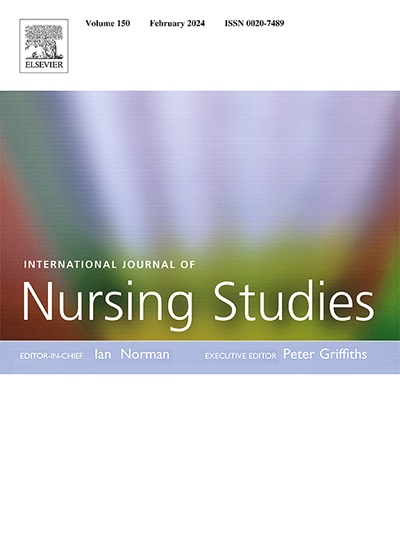Comparative accuracy of osteoporosis risk assessment tools in postmenopausal women: A systematic review and network meta-analysis
IF 7.5
1区 医学
Q1 NURSING
引用次数: 0
Abstract
Background
The Fracture Risk Assessment Tool (FRAX, threshold ≥ 9.3 %), Osteoporosis Risk Assessment Instrument (ORAI, ≥ 9), Osteoporosis Index of Risk (OSIRIS, < 1), Osteoporosis Self-Assessment Tool (OST, < 2), and Simple Calculated Osteoporosis Risk Estimation (SCORE, ≥ 6) have been endorsed by the US Preventive Services Task Force for evaluating the need for bone mineral density measurement by dual-energy X-ray absorptiometry in postmenopausal women.
Objective
To systematically compare the sensitivity and specificity of the five osteoporosis risk assessment tools for detecting bone mineral density-defined osteoporosis.
Methods
A systematic search was conducted across the Cochrane Library, Embase, PubMed and Web of Science databases up to January 29, 2024, to identify observational studies that evaluated comparative accuracy of these tools in postmenopausal women. The Quality Assessment of Diagnostic Accuracy Studies-2 and its comparative extension were utilized to evaluate the risk of bias and applicability. Pooled odds ratios (ORs) and 95 % confidence intervals (CIs) for relative sensitivity and specificity were calculated using a multivariate random-effects model, with tool rankings determined by Surface Under the Cumulative Ranking (SUCRA).
Results
17 studies were included, involving 9669 postmenopausal women with bone mineral density-defined osteoporosis and 34,143 without the condition. The SCORE (OR = 12.11, 95 % CI [4.46–32.86]) exhibited significantly higher sensitivity than FRAX, followed by ORAI (OR = 7.01, 95 % CI [2.84–17.31]) and OST (OR = 6.90, 95 % CI [3.07–15.52]). Compared to OSIRIS, higher sensitivity was observed for SCORE (OR = 4.92, 95 % CI [2.41–10.05]), ORAI (OR = 2.85, 95 % CI [1.63–4.99]), and OST (OR = 2.80, 95 % CI [1.58–4.97]). However, specificity was lower for SCORE (OR = 0.16, 95 % CI [0.08–0.33]), ORAI (OR = 0.26, 95 % CI [0.13–0.51]), and OST (OR = 0.28, 95 % CI [0.15–0.53]) compared to FRAX. Similarly, SCORE (OR = 0.25, 95 % CI [0.15–0.41]), ORAI (OR = 0.40, 95 % CI [0.26–0.62]), and OST (OR = 0.44, 95 % CI [0.27–0.69]) showed significantly lower specificity than OSIRIS. Based on SUCRA values, SCORE (98.2 %) ranked as the most sensitive tool, followed by ORAI (64.2 %) and OST (62.6 %), whereas FRAX (96.7 %) was the most specific, followed by OSIRIS (78.3 %).
Conclusions
The risk assessment tools for identifying postmenopausal women with bone mineral density-defined osteoporosis, endorsed by the US Preventive Services Task Force, can be categorized into two groups. SCORE (≥ 6), ORAI (≥ 9), and OST (< 2) offer higher sensitivity, identifying more osteoporosis patients, whereas FRAX (≥ 9.3 %) and OSIRIS (< 1) provide higher specificity, identifying those without the condition more accurately.
Registration: PROSPERO (CRD42024507532).
绝经后妇女骨质疏松风险评估工具的比较准确性:系统回顾和网络荟萃分析
骨折风险评估工具(FRAX,阈值≥9.3%)、骨质疏松风险评估工具(ORAI,≥9)、骨质疏松风险指数(OSIRIS, <;1)骨质疏松自我评估工具(OST, <;2)和简单计算骨质疏松症风险评估(SCORE,≥6)已被美国预防服务工作组认可,用于评估绝经后妇女用双能x线骨密度仪测量骨密度的必要性。目的系统比较5种骨质疏松风险评估工具检测骨密度定义骨质疏松症的敏感性和特异性。方法系统检索截至2024年1月29日的Cochrane图书馆、Embase、PubMed和Web of Science数据库,以确定评估这些工具在绝经后妇女中的相对准确性的观察性研究。使用诊断准确性研究质量评估-2及其比较扩展来评估偏倚风险和适用性。使用多变量随机效应模型计算相对敏感性和特异性的合并优势比(ORs)和95%置信区间(CIs),工具排名由累积排名(SUCRA)决定。结果纳入17项研究,涉及9669名骨密度定义为骨质疏松症的绝经后妇女和34143名无骨质疏松症的妇女。SCORE (OR = 12.11, 95% CI[4.46 ~ 32.86])的敏感性显著高于FRAX,其次是ORAI (OR = 7.01, 95% CI[2.84 ~ 17.31])和OST (OR = 6.90, 95% CI[3.07 ~ 15.52])。与OSIRIS相比,SCORE (OR = 4.92, 95% CI[2.41-10.05])、ORAI (OR = 2.85, 95% CI[1.63-4.99])和OST (OR = 2.80, 95% CI[1.58-4.97])的敏感性更高。然而,与FRAX相比,SCORE (OR = 0.16, 95% CI[0.08-0.33])、ORAI (OR = 0.26, 95% CI[0.13-0.51])和OST (OR = 0.28, 95% CI[0.15-0.53])的特异性较低。同样,SCORE (OR = 0.25, 95% CI[0.15-0.41])、ORAI (OR = 0.40, 95% CI[0.26-0.62])和OST (OR = 0.44, 95% CI[0.27-0.69])的特异性明显低于OSIRIS。根据SUCRA值,SCORE(98.2%)是最敏感的工具,其次是ORAI(64.2%)和OST(62.6%),而FRAX(96.7%)最特异性,其次是OSIRIS(78.3%)。结论经美国预防服务工作组认可,用于鉴别骨密度定义的骨质疏松症绝经后妇女的风险评估工具可分为两组。SCORE(≥6),ORAI(≥9),OST (<;2)灵敏度更高,识别出更多骨质疏松症患者,而FRAX(≥9.3%)和OSIRIS (<;1)提供更高的特异性,更准确地识别出无此症状的患者。注册:普洛斯彼罗(CRD42024507532)。
本文章由计算机程序翻译,如有差异,请以英文原文为准。
求助全文
约1分钟内获得全文
求助全文
来源期刊
CiteScore
15.00
自引率
2.50%
发文量
181
审稿时长
21 days
期刊介绍:
The International Journal of Nursing Studies (IJNS) is a highly respected journal that has been publishing original peer-reviewed articles since 1963. It provides a forum for original research and scholarship about health care delivery, organisation, management, workforce, policy, and research methods relevant to nursing, midwifery, and other health related professions. The journal aims to support evidence informed policy and practice by publishing research, systematic and other scholarly reviews, critical discussion, and commentary of the highest standard. The IJNS is indexed in major databases including PubMed, Medline, Thomson Reuters - Science Citation Index, Scopus, Thomson Reuters - Social Science Citation Index, CINAHL, and the BNI (British Nursing Index).

 求助内容:
求助内容: 应助结果提醒方式:
应助结果提醒方式:


